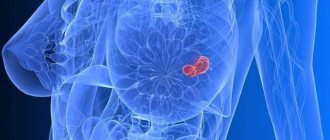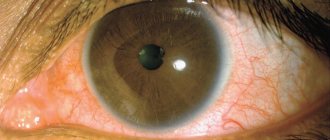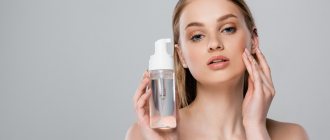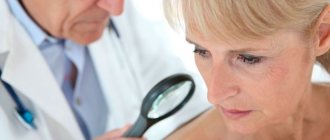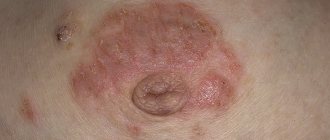| Appointment with a dermatologist at the clinic. Call a dermatologist at home. | Reception is strictly by appointment, make an appointment by phone: +7 | Prices for services | Reviews about the clinic |
A rash under the mammary glands must be diagnosed regarding the reasons for its appearance, since such manifestations cannot be ignored. When rashes appear, it is necessary to understand the reason for this appearance. In the case of periodic appearance of the rash, a general pattern is revealed. In case of unexpected and spontaneous occurrences and the rash does not go away within 4 days, you will need to contact a medical specialist.
Sometimes people consider rashes to be the most natural and common thing that they have to put up with. But you can’t treat your own health this way. The occurrence of rashes, one way or another, cannot be asymptomatic. It is necessary to identify the factor that provoked this appearance, and after that you should already think about getting rid of troubles on the skin, that is, treatment procedures.
Make an appointment with a dermatologist by phone or by filling out the online form
| Select a clinic | Demodicosis | Rash on shoulders | Calling a dermatologist to your home |
Answers to frequently asked questions about skin rashes:
- Which doctor should you contact for a skin rash?
- Is the skin rash contagious?
- What diet is necessary for skin rashes?
- What diagnosis is needed for a skin rash?
- Why is a skin rash dangerous?
- Why is it necessary to get tested for a skin rash?
- What diseases does a skin rash indicate?
- What examination is necessary for a skin rash?
- Which skin rash is dangerous?
- How to distinguish an allergic rash from an infectious one
- How to get rid of skin rashes?
- How to get rid of itching skin rash?
- What organs are affected by a skin rash?
- How to prepare for an appointment with a dermatologist?
- How to get checked for skin diseases?
- What diseases does a dermatologist treat?
- What tests should be taken by a dermatologist?
- What diagnostics can a dermatologist perform in the clinic?
- Where to go with a skin disease?
Where does the rash come from?
The skin located in this area allows you to see certain changes that occur inside the body. The defect in the occurrence of a rash is cosmetic, but its causes, as a rule, are sought directly in the body.
When initial rashes are detected, the state of the body is analyzed and a provoking factor is looked for. Among such factors are:
- The presence of hormonal changes - due to puberty or the menstrual cycle.
- Stressful situations, depression and neuroses.
- Certain medications, such as certain antibiotics.
- Certain bad habits.
- Lack of vitamins.
- Lack of proper nutrition.
- Poor skin care.
- Hypothermia results.
- Overheating from the sun's rays.
All of the above reasons are eliminated if necessary, leveled out or taken under absolute control. For example, it is recommended to take antidepressants and multivitamins, follow a diet, correct regimen, and avoid bad habits.
If your lifestyle is normal, the cleanliness of your skin is guaranteed. When a rash appears due to hormonal changes, treatment is also directly related to the correct regimen. Hormonal imbalance must be avoided. It is quite dangerous when the cause of the rash is one or another disease.
Common symptoms and manipulations in dermatology:
- Skin rashes
- Calling a dermatologist to your home
- Itching in the urethra
- Itchy skin
- Skin rash
- Prevention of casual sex
- Skin neoplasms
- Pyoderma
- Pityriasis rosea
- Streptoderma
- Scabies
- Peeling skin
- Fungal infections
- Skin infection
- Pus on the skin
- Blisters on the skin
- Papillomas on the foreskin
- Sexually transmitted diseases
- Skin structure
Causes of spots and additional signs: table of symptoms
If you find yourself with a spot, check the symptom chart. Some spots are not dangerous and do not even need to be treated. Others are a beacon of serious illness. A spot in the bust area may appear:
- due to allergies (food, care products, synthetic underwear);
- traumatic injury;
- insect bite;
- disruption of the gastrointestinal tract;
- as a result of dyschromia (pigmentation disorders due to stress, metabolic disorders, ovarian dysfunction), for example, vitiligo;
- parasitic diseases;
- fungal infections.
| Spot color | Description of the spots | Additional signs | Possible cause of the problem |
| Red or pink | Purple spots between the breasts (breasts) | Scratches and pain | Tissue damage from bra underwire |
| Urticular (like tubercles) scarlet under the breasts, on the chest, back, neck | Severe itching, rapid increase in area of rashes | Urticaria (food allergy) | |
| Spots in the bust area, small in size, sometimes looking like small bumps or blisters | Sometimes itchy. Sometimes spots appear asymptomatically or due to insomnia | Excessive excitement. Stress Changes in temperature and humidity conditions | |
| Crimson small formations | Itching | Contact dermatitis | |
| Small spots on the bust and abdomen | Mild itching | Miliaria (appears in summer). Drug allergy. | |
| Spots on the bust, neck and abdomen | Itching, pimples, peeling | Eczema developed due to damage to the gastrointestinal tract, due to genetic predisposition or weak immunity | |
| Education in the field of mammary glands | Increase in local temperature, compaction | Lactostasis | |
| Single scarlet spots similar to herpetic formations | Itching, weeping, small bleeding sores, skin erosion and changes in the shape of the nipple | Paget's cancer | |
| Spots in the mammary glands | Hyperemia of the skin of the bust (redness), increased local temperature, thickening of the skin, swelling and pain | Erysipelas-like cancer, characterized by vascular reaction and rapid proliferation of atypical cells | |
| Protruding formation on the skin, congenital or acquired | No | Mole | |
| Minor rashes | Papules, weeping, itching, scabs (crusts) | Herpes | |
| Extensive lesions on the chest and under the breasts | Redness, itching, peeling | Fungus | |
| Redness in the breast area | Increase in local and general temperature, compaction | Mastitis | |
| Brown | Congenital formation, can be of any shape (usually round) from light brown to black | No | Birthmark (mole) |
| A growth that rises above the surface of the skin, pigmented tissue that is spongy | No | Wart | |
| Light brown formations on the skin are initially isolated, then spreading over the entire surface of the bust and abdomen | The spots are slightly flaky and itchy. | Versicolor/pityriasis versicolor | |
| Light-brown (less often scarlet-reddish) areas on the skin of the gland with a diameter of 10 mm, over time merging into one pigmented area the size of a palm | Reduction in the size of the affected gland, hardening and thickening of the skin | Armored cancer | |
| From light to dark brown spots of different sizes | Flat or slightly raised above the surface | Pigment spots. Age-related hyperkeratosis | |
| Blue | The formation looks like a hematoma, single | The compaction is palpable | Nodular form of cancer |
| Formation of blue, greenish, yellowish color | Pain, swelling. During the healing stage, the breasts are slightly itchy | Hematoma | |
| White | Spots of different sizes | White strand (piebaldism). Spots on the face, abdomen (vetiligo) | Leucoderma (piebaldism, vitiligo) |
| Depends on the cause of pigmentation changes | Consequences of psoriasis, favus, eczema, lichen | ||
| Consequences of stress or inflammation. Pigment cells (melanocytes) die due to acute vascular spasm | |||
| Black | Formations of different sizes, flat or raised above the surface of the skin | Sometimes hair grows from the formation | Melanocytic nevus (mole) |
| Formations of different sizes | Spots during pregnancy on the neck and chest of women | Chloasma (melasma) or melasma | |
| Hyperpigmentation (dark, almost black, coloration of the skin) | Symmetrical hyperpigmentation of the neck, feet, intergluteal fold, in the groin, around the lips and armpits, papillomatosis (extensive growth of papillomas), hyperkeratosis (thickening of the skin). | Acanthosis nigricans (negroid) |
Regardless of whether you have one small dark spot or your chest is covered with a scarlet rash, consult a doctor: a dermatologist, mammologist, allergist.
How to treat a rash
The appearance of certain rashes indicates the presence of various diseases that have overtaken the human body. A dermatologist will usually take a close look at the rash under the breasts to determine what is causing it. The diagnosis may be made after an initial examination, but the exact diagnosis is confirmed later after the patient undergoes several tests and a comprehensive examination.
Some types of rashes under the mammary glands can be overcome with anti-inflammatory ointments, as well as special masks. Sometimes rashes occur during pregnancy and then you can use the same procedures.
For hormonal imbalances, medications such as tetracycline may be suggested: a couple of tablets are taken after meals. Another good remedy is tetracycline ointment, which is necessary for external use.
Elimination of allergic rashes is possible by eliminating direct allergens. It could be some kind of clothing, fabric, food, medicine, even a pet. The main thing is to listen to the doctor’s recommendations and you can avoid complications associated with rashes and, finally, get rid of the troubles themselves.
Publication date: 2018-02-07
Methods for diagnosing skin diseases:
- Diagnosis of skin diseases
- Diagnosis of skin diseases at home
- Diagnosis of allergic skin diseases
- Diagnosis of bacterial skin diseases
- Diagnosis of viral skin diseases
- Diagnosis of hair diseases
- Diagnosis of nail diseases
- Diagnosis of skin tumors
- Skin scraping
- Blisters on the skin
- Dermatoscopy
- Demodex tests
- Diagnosis of sexually transmitted infections
- Mushroom tests
- Skin scraping
How to recognize breast diseases and keep your breasts healthy and beautiful
In pursuit of the external beauty of our breasts, we use many products to change the shape, increase volume and tighten the skin... But we often forget about the main thing - the breasts should be healthy!
Signs you should pay attention to and consult a doctor immediately
- Do not tolerate pain in the mammary glands! Pain is your body’s distress signal and its request for help!
- Any changes in the shape, symmetry or size of the mammary glands, changes in the configuration of the mammary glands (retracted areas or protrusions).
- Condition of the nipple and halos (deformation, ulcers, retracted areas).
- The presence of discharge from the nipple and halos, their nature (color, quantity).
- Condition of the skin of the mammary gland (redness, swelling, “lemon” peel).
- Expanded network of blood vessels
- The presence of nodular seals, painful areas.
- Enlargement, hardening or tenderness of the axillary and lymph nodes.
How to recognize breast diseases and keep your breasts healthy and beautiful?
Answer a few simple questions:
- Every month, a few days before your period, do you feel that your breasts are swollen, swollen, and painful?
- Can you feel lumps of different sizes in the mammary glands?
- Do you experience nipple discharge when pressure is applied?
- Are you taking birth control pills?
- Are you taking menopausal or hormone replacement therapy?
- Do you experience constant nagging pain in the mammary glands?
- Are you overweight, have diabetes, or have thyroid disease?
- How long have you been smoking?
- Have any of your close relatives had any cases of breast, uterine or ovarian cancer?
- Have you had a late first birth (after 30 years of age) or have you had an abortion or postpartum mastitis?
- Have you had breast surgery?
If you answered “YES” to at least one question, you need a consultation with a mammologist.
Risk factors for breast cancer:
- first pregnancy over 30 years of age;
- body mass index more than 30 kg/m2, after menopause (insulin resistance);
- menarche up to 12 years;
- alcohol abuse;
- high intake of saturated fat;
- late menopause;
- the woman has a family history of breast cancer;
- carriage of the BRCA1 and BRCA2 genes
We regularly brush our teeth, go for manicures and pedicures, cut our hair, do makeup - and all these are common hygiene procedures for most women. So why does breast self-examination hygiene remain something unnecessary for most women?
Regular examination is a reliable method of preventing breast cancer, especially in women with recurrent breast pain!
Methods for diagnosing breast diseases:
- 1. Self-examination of the mammary glands once a month.
- 2. Examination by a gynecologist at least once a year.
- Ultrasound of the mammary glands is most informative in women under 35 years of age at least once a year. The advantages of the method are as follows :
- safety in terms of dose load;
- no age restrictions;
- high resolution;
- assessment of the condition of silicone breast implants;
- examination of the mammary glands during the acute period of severe mastalgia, injury or inflammation;
- visualization of regional lymph nodes;
- conducting targeted puncture biopsies under objective visual control of palpable and non-palpable formations in the mammary gland;
- pregnant and lactating women;
- examination of children and adolescents;
- dynamic control during treatment;
- monitoring of benign tumors.
- Mammography is an X-ray examination of breast tissue that can detect tumors before they can be felt by palpation. Recommended for all women over 40 years old once a year; for women from 35 to 40 years old, it is performed in case of tumor-like changes during objective ultrasound and other studies. Mammography is necessary before plastic surgery or prescribing hormonal therapy. Mammograms are performed in the first phase of the menstrual cycle (from 5 to 12 days, counting from the first day of menstruation); For menopausal women, images can be taken at any time.
- Biopsy with cytological or histological examination - obtaining, under ultrasound control, a small number of cells or a piece of tumor for examination under a microscope (as indicated).
- Determination of tumor markers (Ca15-3, CEA) are substances that a tumor releases into the human blood. At the same time, the most significant increase in these indicators is observed in malignant diseases, which allows the use of tumor markers, firstly, for early diagnosis of cancer, and secondly, for monitoring ongoing antitumor therapy and early detection of metastases. However, a slight increase in the level of tumor markers in the blood is possible with benign processes and inflammatory diseases of organs. Therefore, the detection of elevated levels of one or another tumor marker is not a basis for diagnosing cancer , but serves as a reason for an in-depth examination of the patient.
- Determination of susceptibility genes BRCA1 and BRCA2
Conducted studies suggest that mutations of these genes are responsible for 30-40% of hereditary predisposition to breast cancer.
OKDC has all the listed modern and relevant methods for diagnosing the condition of the mammary glands.
Breast self-examination
Self-examination should be carried out on the 5-7th day after menstruation or on the same day every month if there is no menstruation.
If you notice any external changes to your breasts or changes in sensation in the breast area, consult your doctor immediately.
Please note that with each passing month, self-examination will become an increasingly simple and familiar procedure for you.
6 Easy Steps to Perform a Breast Exam
(it’s best to do this while standing in the bathroom with soapy hands)
Step 1
Self-examination begins with examining the mammary glands in front of a mirror. Stand up straight, lower your arms along your body. Carefully examine the mammary glands, paying attention to changes in the volume and shape of the breast, as well as changes in the color of the skin, nipple and areola.
Step 2
Raise your hands behind your head. Examine the mammary glands in this position: their shape, the presence of retractions or bulges. Make sure there are no areas of lemon peel or discoloration on the skin. The shape and size of the mammary glands may differ slightly from each other, this is not a sign of a disease, but if these differences suddenly appear or increase, you need to consult a doctor
Step 3
Lightly squeeze the nipple with the thumb and index finger of your opposite hand. Check to see if there is any discharge from the nipple. If there is discharge, be sure to pay attention to its color.
Step 4
Raise your right arm and throw it behind your head. Using the pads of three or four fingers of your left hand, in a circular motion, slowly palpate your right breast.
For a more thorough examination, divide the mammary gland into 4 parts (quadrants) and conduct the examination sequentially - quadrant by quadrant. Repeat the same with the left breast (mirror).
Step 5
Examine the mammary glands in quadrants while lying down. This will allow a more thorough examination of the lower areas of the mammary gland.
Step 6
Feel the armpit and try to locate the axillary lymph nodes. If they have recently become palpable or their shape has changed, then pay attention to this and tell your gynecologist about your observations.
share information
0
Social buttons for Joomla
Diagnostics
Based on the clinical picture, as well as the development of pathology, different examination methods are used. If the disease is mild, self-diagnosis is possible. It includes an initial examination of the spots where the spots are located, as well as their subsequent palpation. In the absence of signs of cancer or mastitis, treatment of an external cosmetic defect is also carried out independently at home. This applies to an allergic reaction, stress, prickly heat, or a side effect from taking medications.
Clinical methods
First, the doctor examines the possibility of the presence of diseases that cause irritation (dermatitis, lichen or allergies). The appearance of red spots on the chest often occurs due to the presence of such diseases. If the listed diseases are excluded, then a number of measures are taken to make a diagnosis. A dermatologist prescribes the following procedures to determine the cause of red spots on the chest:
- Examination and palpation of the breast;
- Blood test for sugar levels;
- Culture for the presence of pathogenic flora;
- Ultrasound;
- Mammography;
- Biopsy or puncture;
- Scraping the affected area.
Therapy methods and drugs
When, based on the tests, the doctor has made an accurate diagnosis, the following therapeutic measures are prescribed to eliminate the cause and rash on the chest in women caused by a specific factor:
- When red dots on the chest occur due to an allergic reaction, which is accompanied by itching, the appearance of a pimply or scaly surface, the patient needs to undergo comprehensive treatment. First, the doctor identifies the allergen, for which a small amount of the possible allergen is injected under the skin. When the exact type is injected, swelling will appear on the skin. For treatment, the following medications are prescribed: antihistamines (Suprastin, Claritin, the use of these drugs is possible even during lactation, due to the absence of a negative effect on the child’s health); hormonal ointments containing hydrocortisone, also known as Elidel - they eliminate itching and reduce redness); hormonal drugs, for example Kenalog (prescribed for allergic dermatitis; for treating pregnant or breastfeeding women, you must first consult a doctor).
- If you have prickly heat, you need to wear loose clothes made from natural materials to allow your skin to breathe. Damaged areas of the skin are treated with special herbal decoctions and a shower is taken every day;
- For psychological disorders, sedatives are prescribed to calm the nervous system;
- In case of eczema, an additional examination is carried out to identify the root cause, due to the impossibility of treating some symptoms;
- For mastitis, massage, regular pumping, the use of medications to reduce fever, and the use of local anti-inflammatory creams or ointments are prescribed;
- With breast cancer, first of all, the stage of development of the disease, as well as the level of localization, is determined. After this, the course of treatment consists of taking medications, surgical removal of the formations, and further radiation and chemotherapy.
Folk remedies
The use of some traditional medicine recipes can eliminate redness of the skin on the chest:
Lemon juice
If a rash appears on the chest, apply lemon juice to the affected area and leave it there for half an hour. Due to its whitening properties, skin redness is eliminated and the skin becomes soft.
Castor oil
Spots on the chest can be eliminated using castor oil. It is applied up to two times a day using cotton wool to the area of skin around the lesion. This has a healing effect and allows you to eliminate external skin defects.
Aloe vera
Gently and gently rub fresh aloe vera gel into the affected area and leave it on the skin for 50 minutes. After this, the area must be rinsed with clean, cool water. Repeat 2 times a day until the desired result is achieved.
Vinegar
Due to certain chemicals found on clothing, red spots may appear on the chest of men or women. To eliminate this defect, vinegar is used:
- You need to mix 100 ml of vinegar with 20-25 liters of hot water, in which to wash clothes, and then dry them in the sun;
- An alternative option is to apply apple cider vinegar to the damaged surface, then wash the skin with soapy water, and then clean but cool. This procedure should be carried out 2 times a day until improvement is achieved.
In what cases do spots go away without requiring treatment?
In the case where increased melanin production is caused by a physiological reason (for example, hormonal changes during pregnancy), pigmentation can go away on its own, leaving no traces behind. As a rule, after delivery, such neoplasms disappear after a few months.
If after childbirth skin defects remain and are present for 1 year or longer, it is recommended to consult a cosmetologist or dermatologist to remove them. Neoplasms that appear during menopause go away on their own. After normalization of hormonal levels, the skin is restored and its original color returns.
When melanin production increases due to the development of a specific disease, it is necessary to undergo specific therapy to eliminate it and, after that, a visit to a cosmetologist to remove hyperpigmentation.
Brown and dark spots
First, you can replace one small spot on your chest that is slightly peeling. As a result of the development of the disease, their number and size increase, and peeling intensifies. They begin to itch, hurt and itch. The causes of brownish spots may be:
- Allergy
- Cancer
- Lichen
- A bite of an insect
- Regular stress
If you do not pay attention to the spots from the moment they appear, the brown spots begin to merge into one whole
It is better to pay attention to the disease immediately so as not to cause a worsening of the condition. Brown spots can be birthmarks, in this case there is no reason to worry or need treatment
Treatment methods
In medicine, there are three options: surgery, radiation therapy and chemotherapy.
- The area infected with the tumor is surgically removed. Here, a distinction is made between organ preservation (removal of the site of infection) and mastectomy (removal of the breast).
- Radiation therapy uses radiation.
- Chemotherapy uses special drugs. Depending on the stage of the disease, these methods can be used either separately or together.
It is also important to conduct preventive examinations, both with a doctor and to independently perform self-examination of the mammary glands
